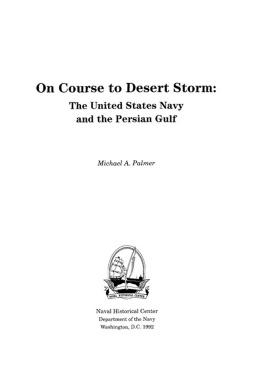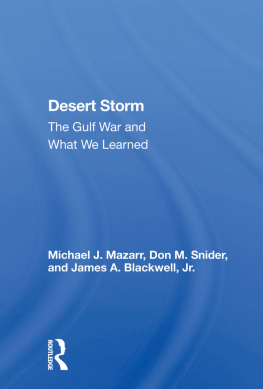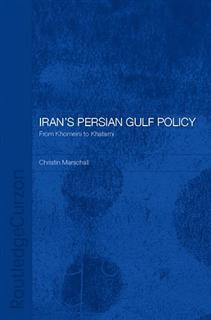On Course to Desert Storm
On Course to Desert Storm:
The United States Navy
and the Persian Gulf
Michael A. Palmer

Naval Historical Center
Department of the Navy
Washington, D.C. 1992
The paper used in this publication meets the minimum requirements of American National Standard for Information SciencesPermanence of Paper for Printed Library Materials, ANSI 239.481984.
Library of Congress Cataloging-in-Publication Data
Palmer, Michael A.
On course to Desert Storm : the United States Navy and the Persian Gulf / Michael A. Palmer.
p. cm. (Contributions to naval history ; no. 5)
Includes bibliographical references and index.
ISBN 0-945274-09-2 (pbk.)
1. Persian Gulf RegionRelationsUnited States. 2. United StatesRelationsPersian Gulf Region. 3. United States. NavyHistory20th century. 4. Persian Gulf RegionHistory, Naval. 5. United StatesForeign relations1945 I. Title. 11. Series.
DS326.P37 1991
956.704'3dc20 9133206
To my mother and father
Secretary of the Navys
Advisory Committee on Naval History
(As of 1 January 1991)
William D. Wilkinson, Chairman
CAPT Edward L. Beach, USN (Retired)
David R. Bender
John C. Dann
RADM Russell W. Gorman, USN (Retired)
Richard L. Joutras
VADM William P. Lawrence, USN (Retired)
Vera D. Mann
Ambassador J.William Middendorf II
VADM Gerald E. Miller, USN (Retired)
Clark G. Reynolds
Daniel F. Stella
Betty M. Unterberger
Contributions to Naval History Series
| Michael A. Palmer, Origins of the Maritime Strategy: American Naval Strategy in the First Postwar Decade | 1988 |
| Thomas C. Hone, Power and Change: The Administrative History of the Office of the Chief of Naval Operations, 19461986 | 1989 |
| Gary E. Weir, Building American Submarines, 19141940 | 1991 |
| Tamara Moser Melia, Damn the Torpedoes: A Short History of U.S. Naval Mine Countermeasures, 17771991 | 1991 |
| Michael A. Palmer, On Course to Desert Storm: The United States Navy and the Persian Gulf | 1992 |
The Author
Dr. Michael A. Palmer is an assistant professor of history on the faculty of East Carolina Universitys Maritime History Program. He is the author of several books on maritime strategy and operations and has published widely in maritime and naval journals. Between 1983 and 1991 he worked at the Naval Historical Center in Washington, D.C., in both the Early History and Contemporary History branches. During this time he wrote Origins of the Maritime Strategy, the first volume to appear in the Contributions to Naval History series. Dr. Palmer earned his Ph.D. at Temple University in 1981. He resides in Greenville, North Carolina, with his wife and two children.
Illustrations
Photographs with NH numbers are held by the Naval Historical Center, Washington, DC 203740571; those with 80G, 306PS, USA C, K, and USN numbers are held in the Still Pictures Branch, National Archives, Washington, DC 204080001; and those with DN numbers are from the Department of Defense Still Media Records Center, Washington, DC 203741681.
Foreword
It is most appropriate that this study, On Course to Desert Storm, is appearing at a time when the Persian Gulf is of special concern to the United States. Michael Palmers purpose is to go behind the recent headlines associated with the crisis that began when Saddam Hussein invaded Kuwait in 1990. The author explains the military and political factors that affected American policy in the region and led to the establishment of the U.S. Navys Middle East Force in 1949. He then traces the evolution of this small force over the ensuing decades. Dr. Palmer shows that the Navy periodically sent major reinforcements to the region during the era of tension and war that followed the abdication of the Shah of Iran in 1979. Starting in the late 1970s these reinforcements included American carrier battle forces, which thereafter became a familiar sight in the North Arabian Sea approaches to the Persian Gulf.
Dr. Palmers broad grasp of naval history makes him exceptionally well qualified to write this far-reaching history. His previous writings include an important study of an undeclared naval war that an infant U.S. Navy waged from 1798 to 1801 against France. The author also contributed a distinguished study of the development of U.S. naval strategy in the years following the Second World War. While preparing On Course to Desert Storm, Dr. Palmer visited the Joint Task Force, Middle East. The opportunity to gain first-hand knowledge of U.S. naval operations in the Persian Gulf added immeasurably to the authors understanding of the subject matter covered in this book.
Among those who contributed to Dr. Palmers work were a number of authorities from outside the Naval Historical Center who kindly reviewed and commented on the manuscript. These readers included Vice Admiral Gerald E. Miller, USN (Retired), who serves as a member of the Secretary of the Navys Advisory Committee on Naval History; Captain Peter M. Swartz, USN, a former member of the Advisory Committee; Dr. Nina Noring, a historian with the Department of State; Mr. Jeffrey Cairns, an analyst with the Central Intelligence Agency; and Lieutenant Commander Joseph T. Stanik, USN, of the U.S. Naval Academys history department.
Within the Naval Historical Center, Dr. William S. Dudley, the Senior Historian; Dr. Edward J. Marolda, Head of the Contemporary History Branch; and Sandra J. Doyle, the Centers senior editor, and her assistant, Akio J. Stribling, deserve special recognition for their contributions to this project.
Despite the assistance offered by these and other individuals, Dr. Palmer is solely responsible for the views and conclusions expressed in On Course to Desert Storm. His opinions do not reflect the position of the Department of the Navy or of any other agency of the U.S. Government.
Dean C. Allard
Director of Navy History
Preface
A Line in the Sand
In the late winter of 1990 President Saddam Hussein of Iraq initiated an anti-Western propaganda campaign. In mid-February he called for the withdrawal of the U.S. Navys Middle East Force from the Persian Gulf waters it had cruised for nearly half a century. In March, despite world outcry, the Iraqis executed an Iranian-born British journalist accused of espionage. In April Saddam threatened to burn half of Israel if the Jewish state struck at Iraq as it had in 1981 when Israeli F16s bombed Saddams Osirak nuclear reactor. These threatscombined with disturbing reports of Iraqi efforts to develop a super cannon, increase the range of Soviet Scud missiles, and purchase atomic detonatorssent shock waves through the Middle East and the West.
In midsummer, Saddam turned his attention to the gulf Arabs, accusing Kuwait and the United Arab Emirates of trying to hold down petroleum prices and weaken Iraq by overproducing oil in collusion with the United States. Saddam needed to increase his oil revenues if he was to pay off the Western and Arab banks and governments that had loaned billions to Iraq during the eight-year war with Iran. He also had to maintain the momentum of his countrys planned economic expansion and to keep nearly a million men under arms. By 21 July, 30,000 Iraqi troops had massed along the Kuwaiti border to underscore Saddams seriousness. As the crisis in the gulf developed, Americans were by no means of one mind regarding an appropriate policy towards Iraq. Some U.S. experts believed that Saddam was a regional and international threat; others considered the Iraqi dictator to be a local bully intent only on shaking down the gulf sheikdoms for some extra cash. Some in Congress were issuing clarion calls about the butcher in Baghdad, while others beat a path to Saddams capital to expand American commercial opportunities in Iraq. By spring the Bush administration was considering taking a tougher stance against Iraq because of its use of poison gas against Kurds and its human rights abuses. But on the eve of the Iraqi invasion of Kuwait a few months later, State Department officials were before Congress fighting against legislative restrictions on United States-Iraqi trade.
Next page













